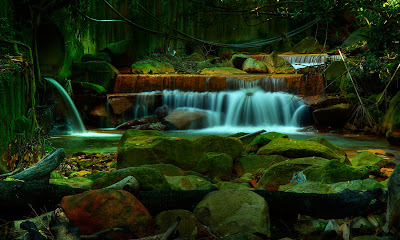
What can a man do if the wife was away for two weeks. Buy a new gadget to play with. I have been playing around the trial version of the software "Photomatix" for over a year and finally decided to get the full version last week. The idea of the software is to take a picture that is perfectly exposed to the high light and a one that is perfect exposed for the shadow to blend them together into a HDR, High Dynamic Range image. Well, our regular computer monitor cannot view the HDR image. It needs to be "tone mapped" to generate a viewable picture. During the ton mapping process, various parameters can be adjusted. It sometimes produced a particular look.
The RAW image of the modern camera already has a very wide dynamic range. Thus a single RAW image can be manipulated to also generate this particular HDR look.
I mean to photo this special mountain stream for a long time. It is very photogenic for two reasons. It originates in a volcanic hot spring and its water contains sulfur, which staines the rock into a reddish gold color. When the stream flows through the forest, the light shinning through the trees gives the rock and stream an added interest.
For the first picture, I used the software to generate a pseudo-HDR using a single RAW image. For the second image, I use Capture NX2 (Nikon's software) first generates a +2 stops over exposed image and a -2 stops underexposed image from a single RAW. I then blended the two together to generate a HDR. The result is interesting and does have a different look.
To see more entries of ABC Wednesday click
here.
 What else to do at Bosque del Apache, photographing the Sandhill Cranes! I got this picture during the last day of our trip to New Mexico last October. They went out during the day to the surrounding area to feed than came back en masse during the sunset, very impressive to watch.
What else to do at Bosque del Apache, photographing the Sandhill Cranes! I got this picture during the last day of our trip to New Mexico last October. They went out during the day to the surrounding area to feed than came back en masse during the sunset, very impressive to watch.

















































